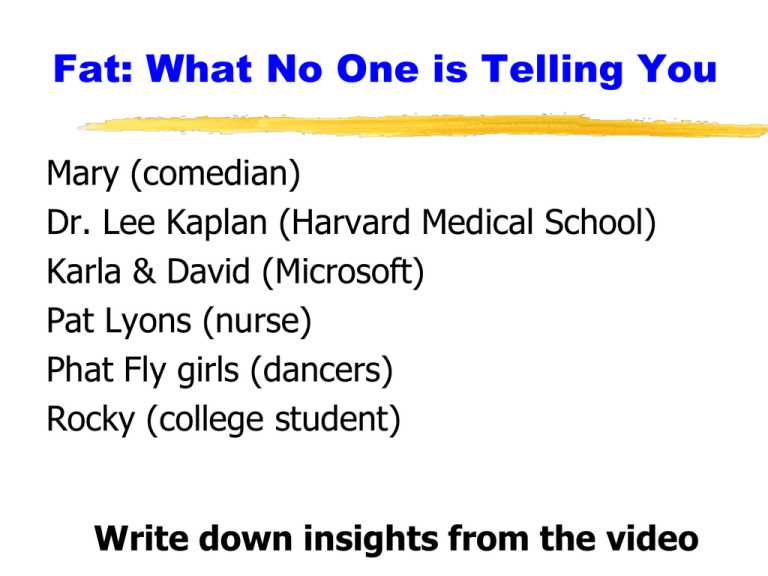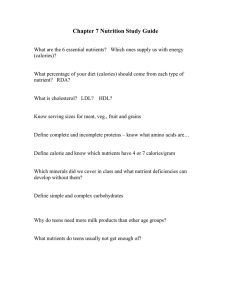Achieving and Maintaining a Healthy Weight
advertisement

Fat: What No One is Telling You Mary (comedian) Dr. Lee Kaplan (Harvard Medical School) Karla & David (Microsoft) Pat Lyons (nurse) Phat Fly girls (dancers) Rocky (college student) Write down insights from the video Overview: Energy Balance and Weight Management Energy (Calorie) Output Metabolism Activity Digestion Energy (Calorie) Intake Guilt Hunger Portion sizes Hormonal changes At any given time… 30% of men are on a diet 45% of women are on a diet Which uses the most calories? Exercise Muscle activity, increase in heartbeat, etc. Metabolism Calories needed for body functions (breathing, organs, temperature, neuro networks, etc.) Digestion Digest, absorb, metabolize the food you eat What burns the most calories? Diets Lower Metabolism 20-40% Calories to Intake Calories to Intake Excess Maintain Maintain Weight Weight 2000 1400 1600 2000 +400 2000 2000 2000 2000 0 Dieting increases fat storage Before the diet After the diet Muscle vs. Fat Tissue While sitting, will you burn more calories if you have more fat or muscle? Muscle tissue is highly active even when at rest Fat tissue is relatively inactive. The more muscle, the higher your metabolism Susan’s Diet Pre-diet Diet Post Diet Total 175 150 179 Lean body 115 105 105 60 45 74 Weight Fat Output: Exercise 15-30% of output Exercise Benefits Increases muscle mass; increases metabolism Helps regulate hunger Increases fat burning enzymes Increases HDL (good cholesterol) Burns calories Output: Digestion 10% of output The energy used to digest, absorb, metabolize and store food Lowest for fat Highest for protein Higher for whole grains with fiber, than refined grains (white bread, white rice) Challenge Question #1 1. Which has the greatest impact on calorie output? a. Exercise b. Metabolism c. Digestion Challenge Question #2 2. Which body tissue keeps your metabolism high? a. Fat b. Skin c. Muscle Factors that may increase calorie intake Guilt Hunger Large portion sizes Hormonal changes for females Diets Create Deprivation & Guilt Deprivation low Guilt high Deprivation high Guilt low G D G D Physical Hunger 1. We all have the inborn ability to eat when hungry, stop when satisfied 2. Hunger: Tells you when and how much to eat 3. Hunger gauge Hunger Gauge __________________________________ 0 1 2 3 4 5 6 7 8 9 10 0-1 = Danger Zone (empty & ravenous) 3 = Hunger 7 = Satisfied 8 = Full Emotional Hunger It’s not our knowledge that has the greatest impact on our behavior, its our emotional balance. When out of emotional balance, we’re more likely to go to excess…food, drink, smoking, spending… To learn more: Intuitive Eating by Tribole MS, RD & Resch MS, RD The Solution or The Pathway by Laurel Mellin, RD, MS Outsmarting the Female Fat Cell by Debra Waterhouse McDonald’s French Fries Year 1970 Size Large Calories 320 1980 Medium Large 320 400 1990 Large Super-size Large Super-size 450 540 540 610 2000 Hormonal Changes A woman’s metabolism varies during menstruation cycle. Lowest 1 week before ovulation Hunger decreases Highest just before menstruation Hunger increases 500 more calories needed during this time Why Diets Don’t Work? Consider what you know about: Calorie output Calorie intake With a classmate, write down 5 reasons low calorie dieting does not work…for the long term. Diet vs Non-Diet Thinking Diet Thinking Non-Diet Thinking Rely on rules (which you are bound to defy) Rely on your inner cues (physical and emotional) Depend on willpower and deprivation I take care of myself with healthy eating. I give myself permission to enjoy all food. Diet vs Non-Diet Thinking Diet Thinking Non-Diet Thinking I shouldn’t eat it. Do I deserve it? Am I hungry? What do I want? Will I feel deprived if I don’t eat it? How much will satisfy? I usually describe food or a day of eating as either “good” or “bad”. I make choices based on health and taste. Diet vs. Non-Diet Thinking 1. Diet Thinking • “Good” Grilled Chicken Deluxe (20 g. fat) • “Bad” Cheeseburger, Large Fries & Soda (35 g. fat) 2. Non-Diet Thinking • Make Choices based on health and taste: Cheeseburger, small fries & small soda (23 g. fat) Cheeseburger, ½ of small fries, water (18 g. fat) Non Diet Approach Give yourself permission to make choices Notice the deprivation/guilt seesaw & jump off Get to know your hunger (physical & emotional) Tune into hunger & how much to be “satisfied” Be active Builds muscle (increases metabolism) Activates fat burning enzymes Helps regulate hunger Notice diet thinking-change to non diet thinking



